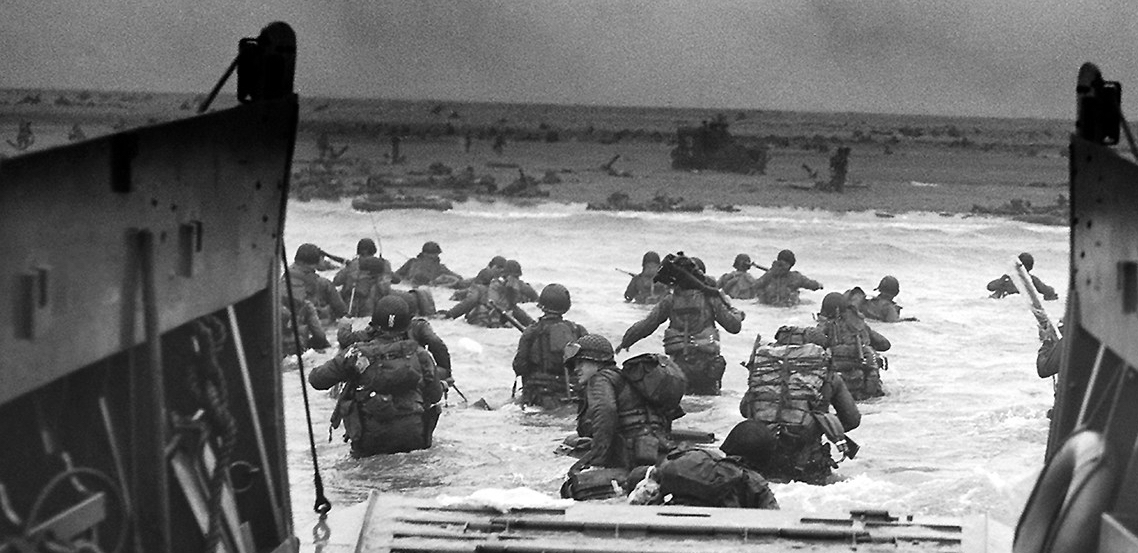The U.S. invasion of Okinawa in 1945 was the largest amphibious campaign of World War II. By this stage in the war against Japan, on paper victory seemed inevitable. Yet the war did not stop. Imbued with a suicidal will to fight, the Japanese refused to quit. As operations on land, sea and air ground relentlessly forward, the enemy threw everything they had into the fight.
Winning against Japan came at a terrible price. On the ships of the U.S. Pacific fleet, sailors in the Okinawa campaign faced a cold, hard reality: their lives were an expendable commodity. Thousands of Americans died on land, sea and air during this final campaign of the war.

The sailors in these photographs had front row seats to hell on earth. They looked across the sea and witnessed enemy aircraft diving into other ships. Their eardrums popped, bent, and burst from a bedlam of noise as thousands of guns fired across the fleet. If they had time to look around, they could see oily black clouds rising into the sky from ships already hit. Every time they manned their battle stations, they faced their own mortality.

The picture below seems impossible. This Japanese kamikaze pilot has managed to get through every defense the U.S. Navy deployed to stop him. He’s flown through the radar picket screen, evading Marine and Navy fighter patrols. He’s dodged around walls of anti-aircraft fire. All that’s left between him and the battleship U.S.S. Missouri (BB-63) is a space measured in heartbeats.

Every American combat ship bristled with anti-aircraft guns, many in open mounts that gave the crews minimal protection. Able to shoot a blizzard of anti-aircraft fire, the Mighty Mo presented a formidable threat to attacking Japanese aircraft. The sailors that manned those guns were much like infantrymen, each formed into a team with a single mission: Protect the ship at all costs.

At all costs. It’s like saying “whatever it takes.” We use these phrases all the time without giving a thought to what they mean. The sailors on Mighty Mo that day knew exactly what at all costs meant. Their lives weren’t as important as their jobs, no matter what it took. They were expendable. Save the ship, save the crew. Do your job like your life depends on it, because it does.

In his last second on Earth, the Japanese pilot clipped the edge of the gunwale with his wingtip. Instead of crashing onto the exposed gun crews, he plowed into the hull a few feet below the deck line. Just like that, he died, while the gun crews lived to fight on. If you visit the Mighty Mo today in her home port at Pearl Harbor, you can still see the dent on the hull that this pilot left in 1945 with his final heartbeat.
Imagine you’re washing your car in the driveway. Suddenly, you see an airplane flying straight toward you. It’s one hundred feet away and coming fast. You realize it’s going to hit your car and you. What would you do?
You’d run away, that’s what. Even if you’ve only seen explosions on TV, instinct screams at you to get the hell out of there. Yet the sailors in the photo remained at their positions. Sure, they felt the icy fear rising in their throats. But their sense of duty kept them firmly planted.
Sometimes, courage is a single event that results in a decoration for bravery under fire. But for many more in combat, it’s the simple act of staying when every fiber in your being urges you to run like your life depends on it.

The gun crews on Mighty Mo always knew they weren’t fighting just for their own lives. They stayed at their stations for their shipmates, for the ship. An accident of fate saved them all from a fiery inferno. They were lucky that day.
Save the ship, save the crew. That’s courage under fire.
Never forget,
Mark
